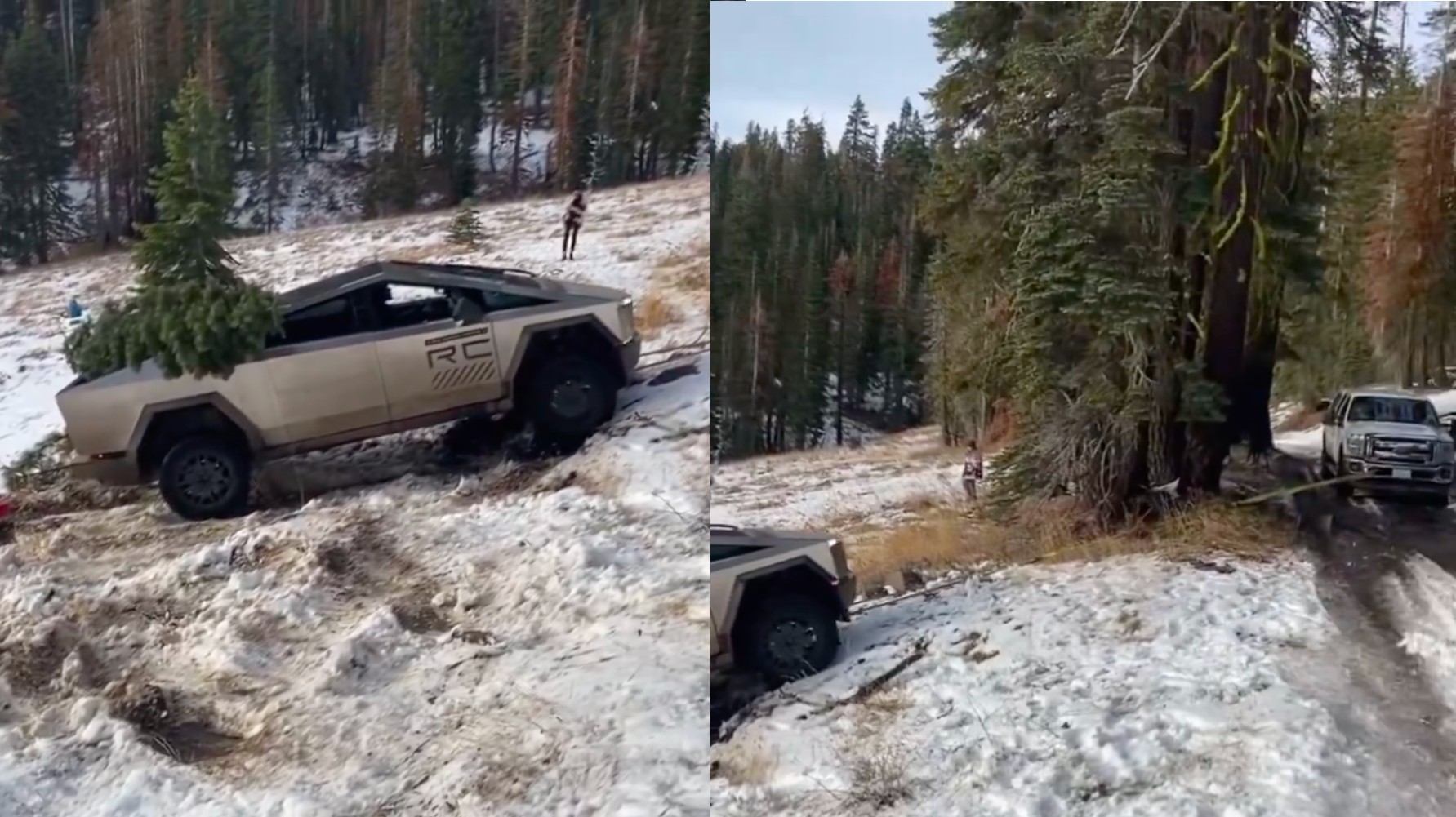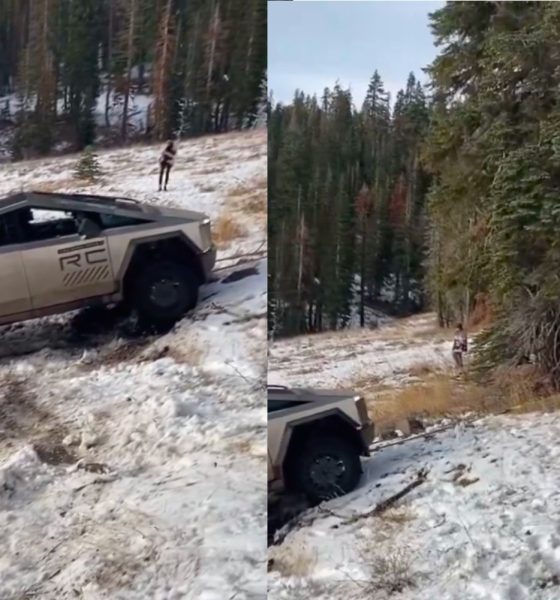

News
Tesla’s inexperienced off-road test drivers are doing a disservice to the Cybertruck (Op-ed)
Elon Musk has noted that the Cybertruck has the potential to become Tesla’s magnum opus. The Cybertruck is designed to dominate on the pavement and off-road. With this in mind, the electric vehicle maker should probably deploy test drivers who are very experienced in rough terrain. Otherwise, Tesla runs the risk of giving the Cybertruck a stigma — one which suggests that the vehicle is inadequate when it comes to “real truck” things.
It is no secret that Tesla already gets a lot of negative attention, and this is particularly true for the Cybertruck. The truck’s appearance alone is enough to warrant anger from critics, so any videos featuring the all-electric pickup truck failing in doing “truck things” will undoubtedly be amplified. This could be seen in social media’s reactions to the Cybertruck’s previous outing at Hollister Hills in California.
The Hollister Hills “Steps” Run
Videos of the Cybertruck back then featured the all-electric pickup truck seemingly struggling up Hollister Hills’ “steps.” Such reactions were amplified further when videos of the Rivian R1T and the Ford F-150 Lightning were shared online, showing both electric pickup trucks taking on the Hollister Hills “steps” without as much difficulty as the Cybertruck.
pic.twitter.com/iFwnC98lYw— ⭕️ CyberMike ⭕️ (@CyberMikeOG) November 15, 2023
Cake walk! Tried to copy what the Cybertruck did https://t.co/t9gkJKfBXw pic.twitter.com/pBDnFw7kcw— omg_Tesla/Rivian (@omg_tesla) November 12, 2023
At the time, Tesla watchers noted that the Cybertruck’s difficulties in the “steps” seemed to be due to the capabilities of its driver, who did not seem very experienced in off-road settings. The Rivian R1T and Ford F-150 Lightning’s drivers, on the other hand, seemed more familiar with such scenarios. The Cybertruck ultimately received quite a bit of flak from critics for being the “worst” among the three electric pickup trucks that took on the Hollister Hills “steps.”
Cybertruck’s Embarrassing Snowy Mishap
More recently, an even more embarrassing video of the Cybertruck has started making the rounds online. This time around, the Cybertruck could be seen getting stuck on a snowy incline. The all-electric pickup truck, which seemed to be carrying a tree on its bed, was evidently stuck, as the driver could be seen pressing on the throttle to no avail. The Cybertruck was ultimately towed out of the incline by a Ford pickup truck.
This is an example of someone without off-roading experience. There is no reason the Cybertruck couldn’t get up that small incline except for an inexperienced driver or this was done purposely to attempt to make the Cybertruck look bad. pic.twitter.com/DuJP6HE7Kd— Miss Jillybean (@MissJilianne) December 12, 2023
yikes https://t.co/bYVNeip2PB— JerryRigEverything (@ZacksJerryRig) December 12, 2023
Longtime electric vehicle owners, especially those who have experience off-roading, have noted on social media that the Cybertruck’s driver could have done a number of things that could have helped prevent the vehicle getting stuck. The all-electric pickup’s tires were evidently not fit for the terrain, and the driver’s actions with the Cybertruck’s throttle gave the impression that there was a lack of off-road experience at play. Some EV watchers even noted that the Cybertruck’s lousy performance on the snowy incline was so bad that it would not have been surprising if the vehicle was being intentionally sabotaged.
Fostering a Negative Narrative
What’s quite unfortunate is that the group that pulled out the Cybertruck actually provided some context about the incident, noting that the vehicle also had a software issue that caused its rear brakes to not act like “lockers.” The Cybertruck in the video was also a release candidate, so it had no recovery or pickup points. These comments from the group that pulled out the Cybertruck provided a good explanation behind the incident, but they did little to shift the narrative. As far as social media was concerned, the Cybertruck had another epic fail off-road, and that was it.
More info on the Cybertruck stuck on a snowy hill: lockers did work, recovery points missing, and wrong tires.
CT wasn’t their only recovery that day ? pic.twitter.com/cmNa4w0hYD— The Cybertruck Guy (@cybrtrkguy) December 12, 2023
When Tesla started deliveries of the Cybertruck, CEO Elon Musk made it a point to highlight how the all-electric pickup truck is a durable and tough vehicle that could survive whatever the world could throw at it. Unfortunately, the Cybertruck has so far not shocked skeptics with its off-road prowess yet. Instead, the evident lack of off-roading experience of its test drivers is simply giving more ammo to those who only wish to see the Cybertruck fail. Hopefully, Tesla could address such issues soon, especially considering the number of EV community members who are both well-experienced in off-road settings and more than willing to help out the EV maker test out the vehicle.
Don’t hesitate to contact us with news tips. Just send a message to simon@teslarati.com to give us a heads-up.

Elon Musk
Starlink passes 9 million active customers just weeks after hitting 8 million
The milestone highlights the accelerating growth of Starlink, which has now been adding over 20,000 new users per day.

SpaceX’s Starlink satellite internet service has continued its rapid global expansion, surpassing 9 million active customers just weeks after crossing the 8 million mark.
The milestone highlights the accelerating growth of Starlink, which has now been adding over 20,000 new users per day.
9 million customers
In a post on X, SpaceX stated that Starlink now serves over 9 million active users across 155 countries, territories, and markets. The company reached 8 million customers in early November, meaning it added roughly 1 million subscribers in under seven weeks, or about 21,275 new users on average per day.
“Starlink is connecting more than 9M active customers with high-speed internet across 155 countries, territories, and many other markets,” Starlink wrote in a post on its official X account. SpaceX President Gwynne Shotwell also celebrated the milestone on X. “A huge thank you to all of our customers and congrats to the Starlink team for such an incredible product,” she wrote.
That growth rate reflects both rising demand for broadband in underserved regions and Starlink’s expanding satellite constellation, which now includes more than 9,000 low-Earth-orbit satellites designed to deliver high-speed, low-latency internet worldwide.
Starlink’s momentum
Starlink’s momentum has been building up. SpaceX reported 4.6 million Starlink customers in December 2024, followed by 7 million by August 2025, and 8 million customers in November. Independent data also suggests Starlink usage is rising sharply, with Cloudflare reporting that global web traffic from Starlink users more than doubled in 2025, as noted in an Insider report.
Starlink’s momentum is increasingly tied to SpaceX’s broader financial outlook. Elon Musk has said the satellite network is “by far” the company’s largest revenue driver, and reports suggest SpaceX may be positioning itself for an initial public offering as soon as next year, with valuations estimated as high as $1.5 trillion. Musk has also suggested in the past that Starlink could have its own IPO in the future.
News
NVIDIA Director of Robotics: Tesla FSD v14 is the first AI to pass the “Physical Turing Test”
After testing FSD v14, Fan stated that his experience with FSD felt magical at first, but it soon started to feel like a routine.

NVIDIA Director of Robotics Jim Fan has praised Tesla’s Full Self-Driving (Supervised) v14 as the first AI to pass what he described as a “Physical Turing Test.”
After testing FSD v14, Fan stated that his experience with FSD felt magical at first, but it soon started to feel like a routine. And just like smartphones today, removing it now would “actively hurt.”
Jim Fan’s hands-on FSD v14 impressions
Fan, a leading researcher in embodied AI who is currently solving Physical AI at NVIDIA and spearheading the company’s Project GR00T initiative, noted that he actually was late to the Tesla game. He was, however, one of the first to try out FSD v14.
“I was very late to own a Tesla but among the earliest to try out FSD v14. It’s perhaps the first time I experience an AI that passes the Physical Turing Test: after a long day at work, you press a button, lay back, and couldn’t tell if a neural net or a human drove you home,” Fan wrote in a post on X.
Fan added: “Despite knowing exactly how robot learning works, I still find it magical watching the steering wheel turn by itself. First it feels surreal, next it becomes routine. Then, like the smartphone, taking it away actively hurts. This is how humanity gets rewired and glued to god-like technologies.”
The Physical Turing Test
The original Turing Test was conceived by Alan Turing in 1950, and it was aimed at determining if a machine could exhibit behavior that is equivalent to or indistinguishable from a human. By focusing on text-based conversations, the original Turing Test set a high bar for natural language processing and machine learning.
This test has been passed by today’s large language models. However, the capability to converse in a humanlike manner is a completely different challenge from performing real-world problem-solving or physical interactions. Thus, Fan introduced the Physical Turing Test, which challenges AI systems to demonstrate intelligence through physical actions.
Based on Fan’s comments, Tesla has demonstrated these intelligent physical actions with FSD v14. Elon Musk agreed with the NVIDIA executive, stating in a post on X that with FSD v14, “you can sense the sentience maturing.” Musk also praised Tesla AI, calling it the best “real-world AI” today.
News
Tesla AI team burns the Christmas midnight oil by releasing FSD v14.2.2.1
The update was released just a day after FSD v14.2.2 started rolling out to customers.

Tesla is burning the midnight oil this Christmas, with the Tesla AI team quietly rolling out Full Self-Driving (Supervised) v14.2.2.1 just a day after FSD v14.2.2 started rolling out to customers.
Tesla owner shares insights on FSD v14.2.2.1
Longtime Tesla owner and FSD tester @BLKMDL3 shared some insights following several drives with FSD v14.2.2.1 in rainy Los Angeles conditions with standing water and faded lane lines. He reported zero steering hesitation or stutter, confident lane changes, and maneuvers executed with precision that evoked the performance of Tesla’s driverless Robotaxis in Austin.
Parking performance impressed, with most spots nailed perfectly, including tight, sharp turns, in single attempts without shaky steering. One minor offset happened only due to another vehicle that was parked over the line, which FSD accommodated by a few extra inches. In rain that typically erases road markings, FSD visualized lanes and turn lines better than humans, positioning itself flawlessly when entering new streets as well.
“Took it up a dark, wet, and twisty canyon road up and down the hill tonight and it went very well as to be expected. Stayed centered in the lane, kept speed well and gives a confidence inspiring steering feel where it handles these curvy roads better than the majority of human drivers,” the Tesla owner wrote in a post on X.
Tesla’s FSD v14.2.2 update
Just a day before FSD v14.2.2.1’s release, Tesla rolled out FSD v14.2.2, which was focused on smoother real-world performance, better obstacle awareness, and precise end-of-trip routing. According to the update’s release notes, FSD v14.2.2 upgrades the vision encoder neural network with higher resolution features, enhancing detection of emergency vehicles, road obstacles, and human gestures.
New Arrival Options also allowed users to select preferred drop-off styles, such as Parking Lot, Street, Driveway, Parking Garage, or Curbside, with the navigation pin automatically adjusting to the ideal spot. Other refinements include pulling over for emergency vehicles, real-time vision-based detours for blocked roads, improved gate and debris handling, and Speed Profiles for customized driving styles.








